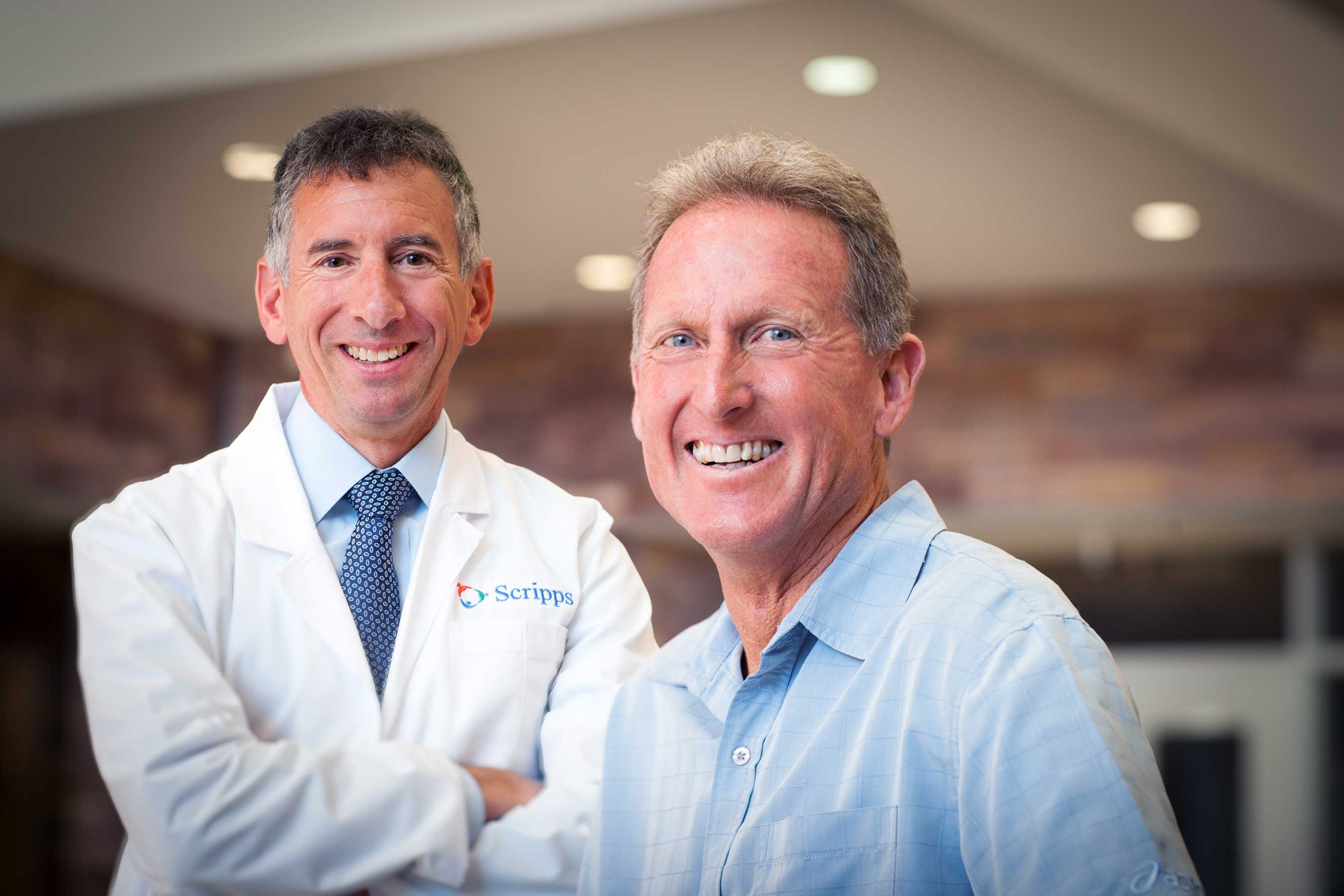Track Legend Steve Scott Reveals Prostate Cancer and Proton Therapy
Treatments at Scripps Proton Therapy Center enable Scott to continue collegiate coaching
“I surrounded myself with the best coaches, trained with the best runners, worked hard and kept a positive attitude,” said the USA Track and Field Hall of Famer.
His success is etched in the record books: 136 times in competition, he ran the mile in less than four minutes – a feat that remains unmatched. The three-time Olympian also held the United States record time for the mile for more than 26 years.
Now 58, Scott is seeking a competitive advantage of a different sort since recently being diagnosed with prostate cancer. Scott publicly revealed his current cancer battle today at the Cougar Challenge, a cross country meet at California State University San Marcos, where he is head coach of the track and field and cross country programs.
After consulting with medical specialists and exploring his treatment options, Scott chose to undergo a unique form of radiation therapy at the Scripps Proton Therapy Center in San Diego. Scott will finish an eight-week course of proton treatment at the end of October, without missing a beat in his current coaching duties or active lifestyle
Sensitive tumor location
The Carlsbad resident said his tumor’s location near a nerve bundle that controls his bowel and sexual functions presented serious concerns. Scott opted against surgery, because doctors would need a “safety margin” around the tumor’s perimeter, which would disrupt the nerve bundle and severely hinder his quality of life.
Scott said he also decided against conventional X-ray radiation therapy – the only other treatment proposed to him by a health system outside of Scripps – in part because of the nausea and fatigue it often causes. But perhaps more disconcerting was a poor family experience with X-rays. Scott’s father passed away from complications associated with X-ray radiation used to treat his prostate cancer.
“The likely side effects involved in my case were unacceptable to me, so I began to look around to see if there were other options,” Scott said. “I was encouraged when I learned about proton therapy, which nobody had told me about. The more I read and spoke with others who had been treated with protons, the more I knew it was right for me. And things really came together for me when I learned Scripps just opened a center in San Diego and I wouldn’t have to travel north to Loma Linda.”
Going public to raise awareness
Scott said he decided to publicly share his story to help raise awareness about the importance of early detection and the availability of proton therapy, because he feels others could potentially benefit.
After his first consultation at the Scripps Proton Therapy Center, Scott was impressed with both the advanced technology and the experienced medical staff. His treating physician, Carl Rossi, M.D., has treated more than 9,000 prostate cancer patients with proton therapy, which is more than any other physician in the world.
“Steve was one of my heroes when I was a distance runner in high school and college,” said Dr. Rossi. “Not only was he incredibly fast, he was also fearless. Unlike some of his world-class contemporaries, he would race anybody, any time. Not surprisingly, he has taken the same fearless approach to his cancer diagnosis and treatment. He researched his options, decided on a course of treatment, and is ready and willing to share his experiences with others.”
Active during treatments
Scott said he’s been able to maintain an active lifestyle during treatments, which includes coaching and running three to five miles a day, spending quality time with family and public speaking engagements. He has helped establish Cal State San Marcos as one of the most successful running programs in the National Association of Intercollegiate Athletics (NAIA), including three national titles. On Nov. 6, his men’s and women’s cross country teams will compete in their conference championship meet, followed by the national championship meet Nov. 26.
A strong outlook
According to Dr. Rossi, Scott began his treatments with an intermediate-risk tumor. The goal of his proton therapy is to eradicate the tumor, resulting in a cure. Dr. Rossi said Scott’s prognosis is good to excellent, though he will require years of follow-up visits for monitoring.
Research has demonstrated the effectiveness of proton therapy in treating many cancers, including prostate cancer. A 2014 survey found that 97 percent of prostate cancer patients who received only proton therapy have not experienced a recurrence. This study included nearly 4,000 patients from across the United States. Earlier, a study led by MD Anderson Cancer Center found that proton therapy preserves quality of life, specifically urinary and bowel function.
Prostate cancer is the second-leading cause of cancer death in the United States, behind only lung cancer, according to the American Cancer Society. More than 29,000 prostate cancer deaths are expected in the United States in 2014.
Proton therapy is a form of radiation treatment that kills cancer cells while preserving healthy surrounding tissue. Conventional radiation treatments use X-rays, which penetrate into normal tissue around the tumor and increase the probability of side effects and secondary cancers. But a proton beam can be controlled to stop where the tumor stops.
The Scripps Proton Therapy Center uses pencil-beam scanning, the latest advancement in proton therapy. Pencil-beam scanning sweeps a narrow proton beam across the tumor in fine strokes, building up the dose layer by layer. The result is a dose of cancer-killing radiation that conforms precisely to the unique shape of the tumor.
A non-invasive treatment, proton therapy has been shown to be highly effective for adults and children who have solid, deep-seated tumors that have not spread to distant parts of the body. Proton therapy has been used in the United States since the 1950s but is only recently becoming more available. The Scripps Proton Therapy Center opened earlier this year for adult and pediatric patient care. It is just the 15th proton center in the United States and fourth west of the Rockies.
Advanced Particle Therapy is the developer and owner of the Scripps Proton Therapy Center facility. Scripps Health provides the center’s clinical management services and Scripps Clinic oversees the medical services. Varian Medical Systems of Palo Alto, Calif., developed and installed the center’s ProBeam® proton delivery system.
ABOUT SCRIPPS HEALTH
Founded in 1924 by philanthropist Ellen Browning Scripps, Scripps Health is a nonprofit integrated health system based in San Diego, Calif. Scripps treats a half-million patients annually through the dedication of 2,600 affiliated physicians and 13,750 employees among its five acute-care hospital campuses, hospice and home health care services, and an ambulatory care network of physician offices and 25 outpatient centers and clinics.
Recognized as a leader in the prevention, diagnosis and treatment of disease, Scripps is also at the forefront of clinical research, genomic medicine and wireless health care. With three highly respected graduate medical education programs, Scripps is a longstanding member of the Association of American Medical Colleges. In 2014, Truven Health Analytics named Scripps one of the top five large health systems in the nation for the third year, and Scripps hospitals are consistently ranked by U.S. News & World Report among the nation’s best. Scripps is regularly recognized by Fortune, Working Mother magazine and AARP as one of the best places in the nation to work. More information can be found at www.scripps.org.
# # #









.png)